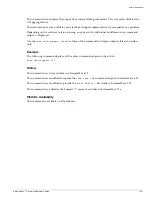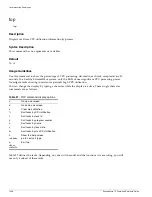
ExtremeWare 7.5 Command Reference Guide
1245
14
Wireless Commands
The Alpine switches, Summit 300 series switches and the Altitude 300 wireless port extend network
service to wireless 802.11a/b/g clients within a fully integrated network infrastructure. Ports on the
Summit 300 switch handle all of the management functions typically associated with an access point.
The Altitude 300 wireless port serves as the radio transmitter and receiver, inheriting configuration
information as soon as it is attached to the switch and as changes are made to the wireless profiles after
the system is deployed.
Summary of Wireless Features
The Alpine and Summit 300 series switches support the following wireless features:
•
Simultaneous support for 802.11a, 802.11b, and 802.11g
•
EAP authentication for 802.1X devices—Protected Extensible Authentication Protocol (PEAP), EAP
Tunneled TLS Authentication Protocol (EAP-TTLS), and Extensible Authentication Protocol
Transport Layer Security (EAP-TLS)
•
Wi-Fi Protected Access (WPA) using Temporal Key Integrity Protocol (TKIP) and Advanced
Encryption Standard (AES)
•
Per-user VLAN classification
•
AccessAdapt™ management
•
Remote troubleshooting
•
Easy upgrading of wireless ports
•
Detailed reports and logging
Wireless Devices
You configure ports on the Summit 300 or Alpine switch with the “personality” of the device to be
connected. Each port contains separately configurable interfaces for each of its two radios (A and G).
Physical security for the wireless networks ceases to be a problem at the wireless access location
because the Altitude 300 wireless port does not store any security settings. Information is not stored in
the Altitude 300 wireless port, but loaded as needed from the switch. Even if the Altitude 300 wireless
port is physically moved, it can only be reconnected to another Summit 300 model.
You can set network policies at layers 2 and 3 to cover both the wired and wireless networks. In this
way you can block access to individuals suspected of intrusion across the entire network infrastructure.
Summary of Contents for ExtremeWare 7.5
Page 402: ...402 ExtremeWare 7 5 Command Reference Guide VLAN Commands ...
Page 470: ...470 ExtremeWare 7 5 Command Reference Guide QoS Commands ...
Page 490: ...490 ExtremeWare 7 5 Command Reference Guide NAT Commands ...
Page 826: ...826 ExtremeWare 7 5 Command Reference Guide Commands for Status Monitoring and Statistics ...
Page 1090: ...1090 ExtremeWare 7 5 Command Reference Guide Security Commands ...
Page 1386: ...1386 ExtremeWare 7 5 Command Reference Guide Wireless Commands ...
Page 1436: ...1436 ExtremeWare 7 5 Command Reference Guide EAPS Commands ...
Page 1568: ...1568 ExtremeWare 7 5 Command Reference Guide ESRP Commands ...
Page 1844: ...1844 ExtremeWare 7 5 Command Reference Guide IGP Commands ...
Page 1930: ...1930 ExtremeWare 7 5 Command Reference Guide BGP Commands i Series Switches Only ...
Page 2022: ...2022 ExtremeWare 7 5 Command Reference Guide IP Multicast Commands ...
Page 2066: ...2066 ExtremeWare 7 5 Command Reference Guide IPX Commands i Series Platforms Only ...
Page 2082: ...2082 ExtremeWare 7 5 Command Reference Guide ARM Commands BlackDiamond Switch Only ...
Page 2094: ...2094 ExtremeWare 7 5 Command Reference Guide Remote Connect Commands ...
Page 2174: ...2174 ExtremeWare 7 5 Command Reference Guide PoS Commands BlackDiamond Switch Only ...
Page 2372: ...2372 ExtremeWare 7 5 Command Reference Guide LLDP Commands ...
Page 2422: ...2422 ExtremeWare 7 5 Command Reference Guide H VPLS Commands BlackDiamond Switch Only ...
Page 2528: ...2528 ExtremeWare 7 5 Command Reference Guide MPLS Commands BlackDiamond Switch Only ...
















































